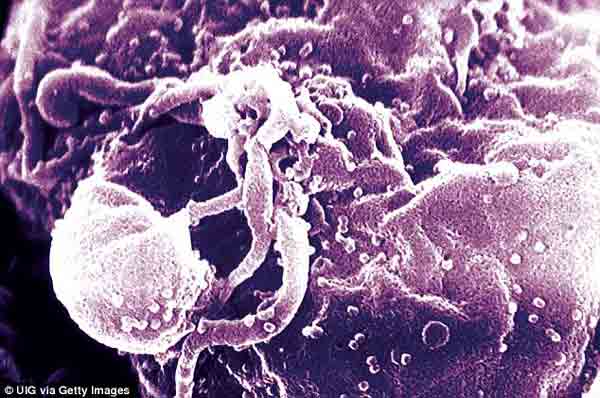

Researchers have solved the final unknown structure of the HIV virus, which is largely responsible for the envelope spikes that allow the virus to attach to receptors of healthy cells and replicate it. University of Alabama at Birmingham researchers say that understanding this structure could lead to therapies to 'disarm' the virus. Photo: UIG via Getty images
Birmingham, UK (BBN) - Researchers have figured out the final piece in the structural puzzle of the HIV virus. A complete picture of the HIV virus had been short a segment of one of its 15-component protein, until now.
The newly-modeled cytoplasmic tail is involved in the assembly of the outer shell of the HIV virus, which attaches to a host cell and begins the process of replication, reports Daily Mail.
The researchers claim that if this part of the viral cell’s assembly can be stopped, the HIV virus will not be able to replicated and spread in the body.
After two years of attempts, the University of Alabama at Birmingham team was able to recreate the cytoplasmic tail’s structure, which they hope will open up a number of new avenues of research into possible therapies for HIV treatment.
Since the HIV virus was discovered in 1983, scientists have spent the last 30 years figuring out what its component parts are and how they work in concert to create such a lethal killing machine.
We now understand that HIV is made up of 15 proteins and its own genome, the RNA that codes for HIV’s replication.
But this final segment of one of those proteins has ‘eluded many labs for over 20 years,’ says Dr Jamil Saad, who led the University of Alabama research team.
He and his team spent two frustrating years trying to work out this final structure. ‘I wanted to quit so many times,’ he says, ‘but I have a persistent group that kept going until we got it,’ he says.
The cytoplasmic tail is the name of a structure inside a key protein of the HIV virus.
That protein codes for an envelope spike, or a structure on the membrane that encases the HIV virus, and the cytoplasmic tail is involved in how that envelope comes together with the rest of the virus cell.
‘This segment we saw is the internal anchor for a spike [which can] move on the surface of an HIV cell to engage host receptors,’ says Dr Saad.
HIV’s envelope spikes allow it to attach to a host cell and infect it. ‘It’s really the first point of attack on humans,’ he says.
Dr Saad says that if you cut off the cytoplasmic tail that he and his team have now decoded, the spike won’t be incorporated into the HIV virus.
According to Dr Saad, well-known HIV researcher Dr Peter Kwong of the National Institutes of Health visited his lab and thought the research was promising for the development of new vaccines for HIV.
So the discovery ‘might even lead to new approaches to inhibit this process, which means disarming the virus,’ he says.
BBN/MMI/ANS